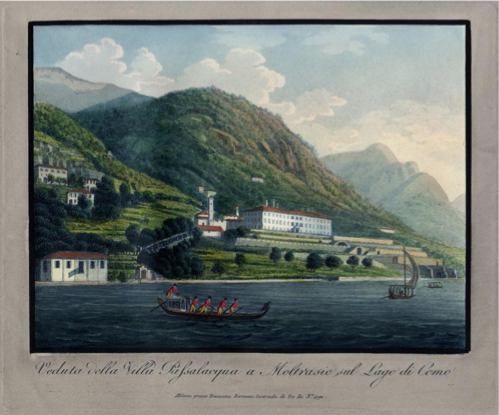Luxury Villa for Rent: Villa Passalacqua
You can enjoy the lifestyle of George Clooney and Richard Branson by renting one of the luxurious villas on Lake Como. Elite Club’s absolute favourite villa for rent is Villa Passalacqua. This unique, wonderful and splendid mansion has a rich history and aristocratic ambience.
Below is the most exciting story of all times, it is the love story of Nobel families and rich merchants that were lucky to own and live in the Villa Passalacqua through centuries.
Julius Caesar and Moltrasio
Lake Como was formally recognized by Julius Caesar in the first century BC when he sent aristocratic Greek and Roman families to colonize the area. Moltrasio plays a role in this early history as its hard, grey stone became the primary source material for the ancient stone walls, communities and palaces of the Lake Como region.
La Chiesa Sant’ Agata

According to variations of her legend, having rejected the amorous advances of a Roman Prefect, she was persecuted by him for her Christian faith. Among the tortures she underwent was the cutting off of her breasts. She is therefore often depicted iconographically carrying her excised breasts on a platter.
Inside La Chiesa di Sant’ Agata is the beautiful Villa Lucini Passalacqua chapel with medieval relief taken from the ancient Sant’ Abbondio in Como.
Pope Innocent XI and the Villa Passalacqua

We now move forward to Pope Innocent XI and his sister, Lucrezia Odescalchi. Pope Innocent XI (May 16, 1611 – August 12, 1689), born Benedetto Odescalchi, was Pope from 1676 to 1689. He was born in Como in 1611, and was educated there by the Jesuits. The Villa Passalacqua sits on the land that Pope Innocent XI gave to his sister, Lucrezia Odescalchi. She built a small country villa where the Villa Passalacqua was later constructed. Some time in the late 17th century she gifted the property to the Passalacqua family. Count Andrea Luccini-Passalacqua started the construction of the Villa Passalacqua. The small Odescalchi villa was torn down to make way for the Palazzo di Moltrasio.

Count Passalacqua wanted to construct one of the largest villas on Lake Como and, in that, he succeeded. To the surprise of many, he hired the little known architect, Felice Soave—instead of his more famous brother. By the end of Felice’s life, he greatly surpassed his brother for prominence in architecture. The Count also hired the great Giocondo Albertolli who not only designed the inside of the villa but painted three frescoes in the Music Room. Albertolli would have been very expensive as he was already famous for having done much of the decorative work for the Uffizzi gallery in Florence and the Palazzo Reale in Milano.
The result is one of the largest villas on Lake Como. As Felice Soave wanted it, the Villa is plain on the outside and highly ornate and spectacular on the inside. Albertolli’s prestige helped Count Passalacqua land Andrea Appiani to paint two frescoes in the villa. One is in the Dining Room and the other is in the Drawing Room. Appiani was made pensioned artist to the Kingdom of Italy by Napoleon, but lost his allowance after the events of 1814 and tragically fell into poverty. During his stint as court painter he rendered portraits of Napoleon and the chief personages of his regime.
Vincenzo Bellini

He carried on a torrid love affair with the Contessa Giuditta Cantù while sojourning in the Villa Passalacqua. She lived in the nearby Villa Hocevar which still remains intact. Giuditta Cantù was the unhappy wife of Ferdinando Turina a very rich owner of a silk factory and of extensive properties. The more malicious were convinced that this relationship was the result of precise, cool-headed calculation, as Bellini himself seems to suggest in a letter he wrote in 1828 to Francesco Florimo, the music historian, his friend and most authoritative biographer. These “lapses of style” make it difficult to understand his character completely; indeed his friends and biographers offer different and conflicting descriptions: “a pure soul, sweet, grateful, modest, impassioned, fiery, reckless” (Florimo); “a volcanic character, ready to burst into flame” (Giovanni Ricordi); “his character was quite noble and kind. His soul was surely always pure and was never tainted by any ignoble trait” (Heinrich Heine).
Bellini escaped to Paris after Ferdinando Turina had enough embarrassment from his wife’s affair. He died two years later on the outskirts of Paris from inflamed intestines.
As the 19th century progressed, the Passalacqua family squandered their fortune until they were forced to sell the villa in 1910. Some of the older people in Moltrasio still have tales passed down to them by their parents of some of the antics of the Passalacqua family. One such story was that one young, philandering Passalacqua and his friend painted their nude bodies white and stood as if Greek statues on the lake’s shore. As the large passenger boat arrived they suddenly gestured grotesquely to the prudish ladies on the boat and than ran inside the underground tunnels of the Villa Passalacqua.
Lady Nalder

The Unusual Oscar Kiss Maerth
This story is not complete without an understanding of Oscar Kiss Maerth. Kiss Maerth was born in Hungary (back then it was known as Yugoslavia) in 1914. He travelled extensively in Asia and was involved in the shoe and silk trade.

Kiss Maerth is the author of The Beginning Was the End (1971), a pseudo-scientific book written in a Chinese monastery that claimed modern man devolved from a species of brain-eating apes. Kiss Maerth’s philosophy on the origins of man became the inspiration for much of the music of the “Art Rock Band” DEVO.
An American family purchased the Villa Passalacqua from Elizabeth Kiss Maerth in 2000.













